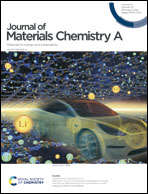Ultra-robust, highly proton-conductive polymer carbon dot membranes through bioinspired complexation†
Abstract
Robust and highly conductive proton exchange membranes are urgently required in fuel cells. Inspired by the underwater adhesion of sandcastle worms, herein, ultra-robust and highly conductive polymer carbon dot membranes (PCDMs) were fabricated via electrostatic complexation between zero-dimensional acidic group functionalized polymer carbon dots (PCDs) and sulfonated polyether ether ketone (SPEEK) in water solution. PCDs with different acid groups were designed to modulate the electrostatic complexation. The superior interface compatibility endows PCDMs with the highest PCD content of 50 wt%, meanwhile, phosphate functionalized PCDs endow the PCDMs with abundant proton transport sites and a low energy barrier proton transport pathway. As a result, the corresponding PCDMs exhibited a high proton conductivity of 264 mS cm−1 under 100% RH at 80 °C. Meanwhile, the PCDMs exhibited a high stress of 56 MPa and dimensional stability under 100% RH at 80 °C.



 Please wait while we load your content...
Please wait while we load your content...